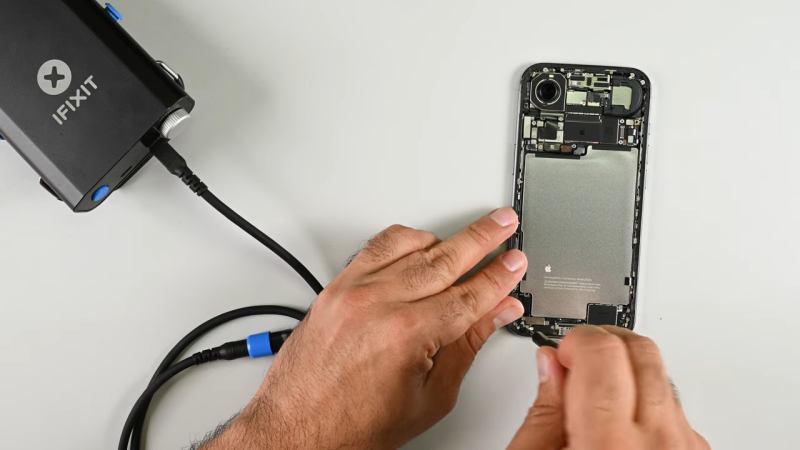Miniaturization is a trend that comes and goes in the cellular phone space. For a while, our phones were all getting smaller, then they started getting bigger again as screens expanded to show us ever more content and advertising. The iPhone air is going back the other way, with a design that aims to sell based on its slimness. [iFixit] reckons that despite its diminutive dimensions, it should still be quite repairable.
“Thinner usually means flimsier, harder to fix, and more glued-down parts, but the iPhone Air proves otherwise,” states Elizabeth Chamberlain for the repair outlet. Much of this comes down to clever design, that makes repair possible at the same time as ensuring compactness. A big part of this is the way that Apple made the bottom half of the phone pretty much just battery. Most of the actual electronic components are on a logic board up by the camera. Segmenting the phone in this way makes it easier to access commonly-replaced parts like the battery without having to pull a lot of other parts out of the way first.
[iFixit] refers to this as flattening the “disassembly tree”—minimizing the number of components you have to touch to replace what you’re there to fix. In this regard, the thinness of the iPhone Air is actually a boon. The phone is so thin, it wasn’t possible to stack multiple components on top of each other, so everything is easier to get to. The design is also reasonably modular, which should make routine repairs like USB C port swaps relatively straightforward.
Whatever smartphone you’re working on, it often helps to have a disassembly guide to ensure you don’t wreck it when you’re trying to fix something. [iFixit] remains a stellar resource in that regard.
















Tip for presenter: don’t hold up a thin black thing against your black T-shirt to show how thin it is.
Unless each individual component could have a serial number and digital signature that a trusted hardware module could check against. I’m not holding my breath.
At least my Pixel would allow that:
https://www.youtube.com/watch?v=xxiDm7JAGz0
Do these Malus devices come with 7 year patch support?
“Do these Malus devices come with 7 year patch support?”
They do and have history of being better in this field than any android company for more than decade. This was main reason I gave Apple a try – my SE2020 still receives updates.
You can compare iPhone support:
https://endoflife.date/iphone
To Pixel support:
https://endoflife.date/pixel
TLDR:
iPhone4 released on 2011 reached end of support in 2019.
iPhone XS released on 2018 is still supported.
So how thin is it? I’m not going to watch the video.
Dunno, I watched the video and the person held the black iPhone against his black shirt.
5.6mm – pretty slim but sub 6mm Android were on the market in 2015.
Thin for the sake of thin is pointless if the part that matters most sticks out like a boulder. Either make the whole thing genuinely integrated and functional, or stop pretending thinness is the ultimate achievement when the camera dictates the real form factor.
Think about it: pockets, flat surfaces, stability — all ruined by that protruding camera block. Set the phone down and it wobbles like a cheap tripod. Try to slide it into a tight pocket and the bump catches on everything. They add bulk to hide the bump, which defeats the entire “we made it thin” narrative.
Apple can trumpet a thinner chassis until the cows come home, but customers end up carrying a brick-shaped compromise in their pocket anyway.
If the camera sits on the back like a friggin’ rock, the whole “ultra-thin” flex is nonsense. This is a phone with a built-in topography problem. Shaving fractions of a millimeter off the body doesn’t mean anything when the phone still carries a giant hump on its back.
Not to mention I feel like this is solving a problem that doesn’t really exist. After a certain point, the phone is simply thin enough and Getting Thinner doesn’t seem like it really helps anything.
You know what does help a real issue? Better battery capacity.
If they would just make the phone a consistent thickness even with the camera lenses, and use the increased volume for a larger battery, it would be an objectively better product and address an issue that I guarantee is more important to more people.
I personally disagree. If you have a well-designed case, it often uses that thickness difference to get you good protection without increasing thickness over the bump much. Without a case, the phone (in my open nion) will sit better in your pocket than a rectangle that’s all at the max thickness.
This is an extremely subjective thing, though. To each their own.
I agree and disagree. I think this is a discussion of terminology. Overall, the phone is much thinner, except where it isn’t. Since it isn’t uniform, you can no longer make uniform statements about its shape. The bulge may matter to some people, and not matter to others. So, to say it “doesn’t mean anything” might be the case for you, it’s not necessarily the case for other folks.
From a users point of view it probably is ultra-thin – will fit in most any pocket, even if the bump sticks out, will be annoyingly thin to hold on to, so you are bound to drop it in use as the edges are all so thin etc. So yeah not saying I think much of the thinness craze, but with or without the camera bump it would IMO feel very much the same for the user.
Apparent repairs are the best kinds of repairs.